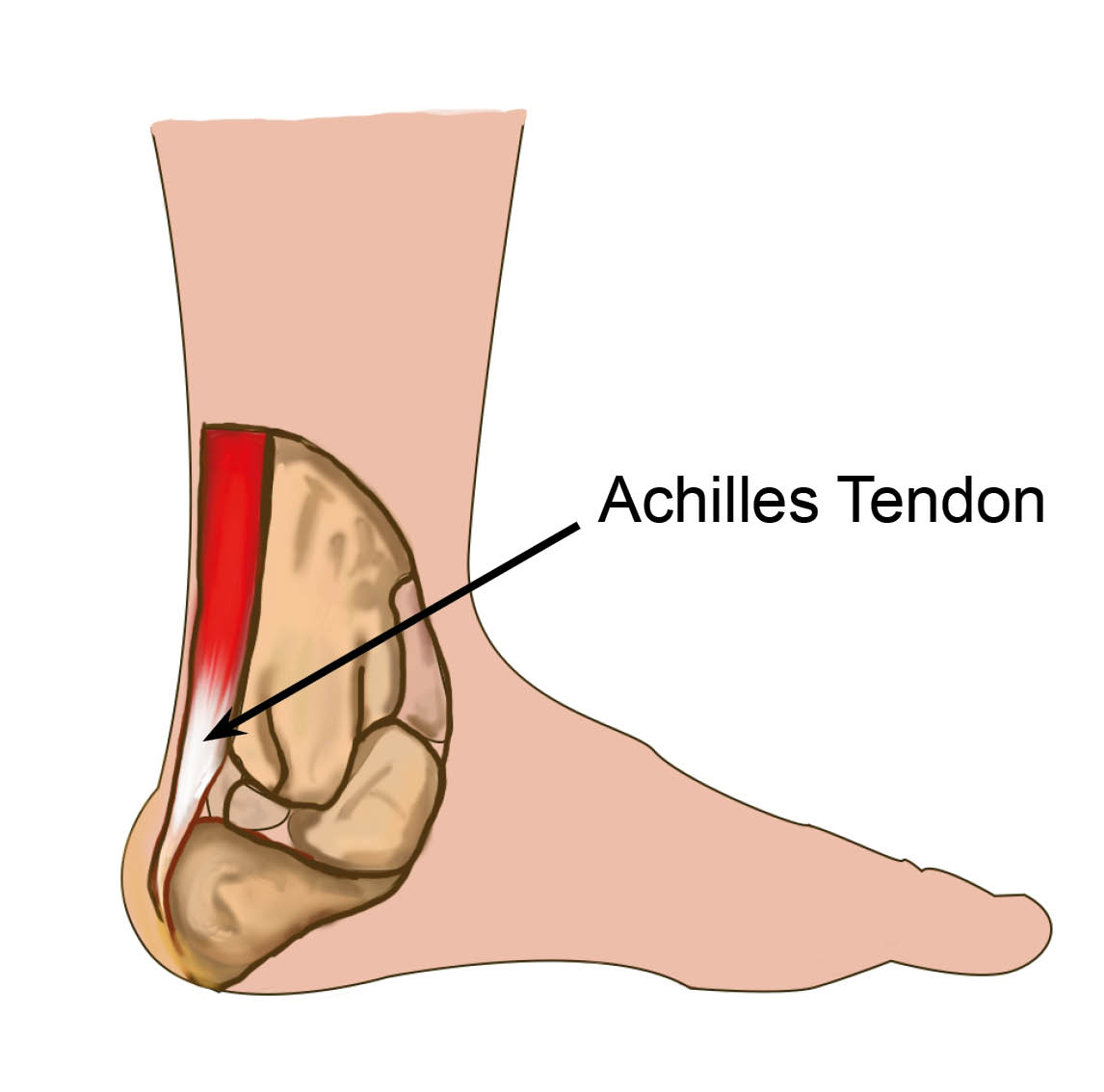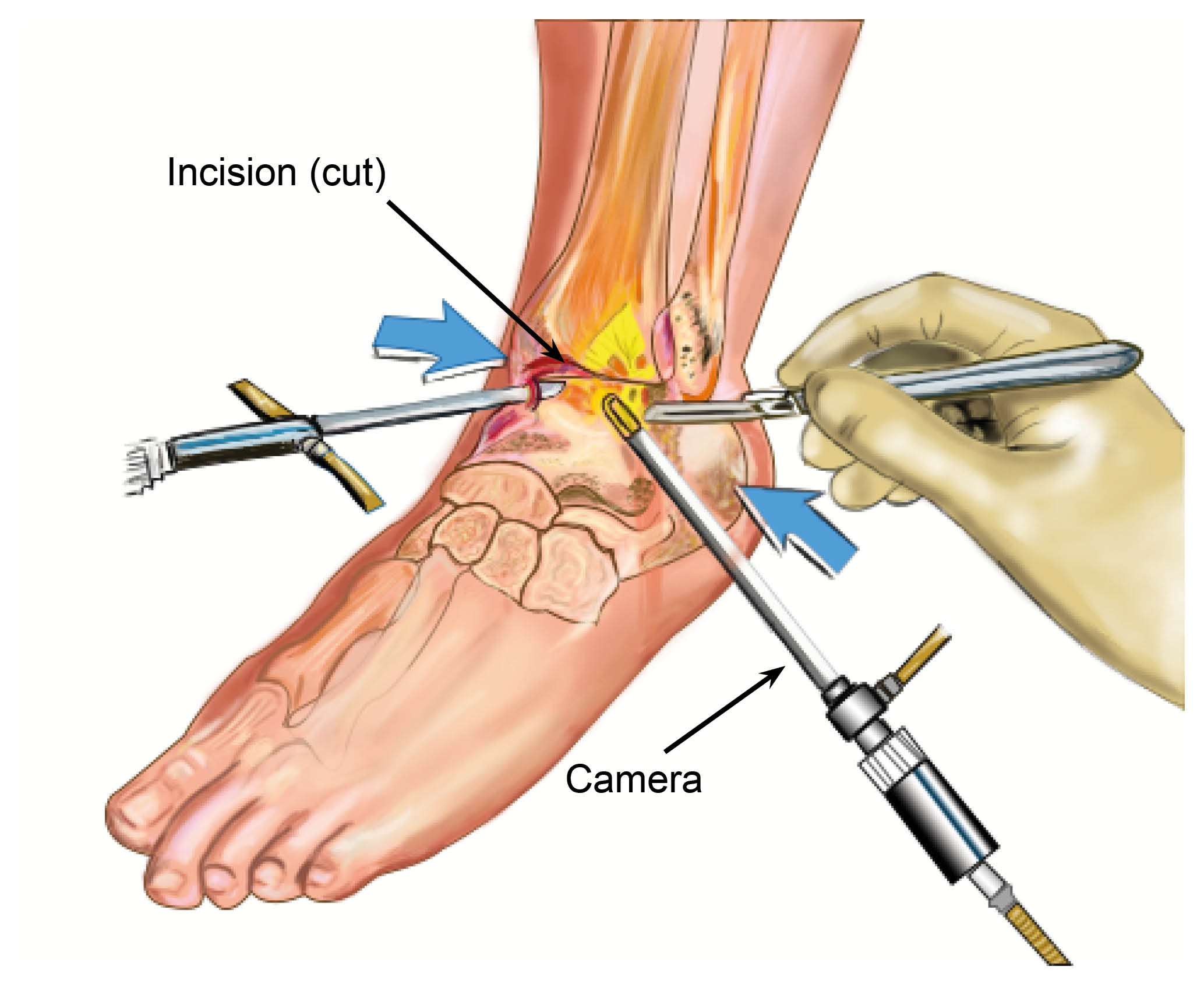Ankle arthroscopy
Information for patients from Trauma and Orthopaedics
You have been referred to the hospital for an ankle arthroscopy. This leaflet will explain:
what an ankle arthroscopy is
what happens during and after the procedure
what the alternatives are; and
what risks there are to having this procedure.
We hope this leaflet helps to answer some of the questions you may have. If you have any further questions or concerns, please speak to a member of your healthcare team.
What is an ankle arthroscopy?

Ankle arthroscopy is a keyhole surgery. Keyhole surgery allows a surgeon to use small cuts and a camera for procedures.
Your surgeon will make two small incisions (5 to 10mm cuts). This will allow them to see your ankle joint and its surrounding area. Usually they will make the incisions at the front of your ankle. If the problem is at the back of your ankle, you will need to lay on your front and two incisions will be made either side of your Achilles Tendon.

Your surgeon will pass a camera into the joint, through one of the incisions and the image is shown on a screen. The other incision is used so instruments can enter the joint.
During your operation it may be necessary to swap the camera and instruments to the other side. This will give your surgeon better access to your ankle.
What procedures can be performed with arthroscopy?
Arthroscopy can be used to help with various conditions, including the following.
Removal of soft tissue impingement and bone spurs.
Removal of loose bodies (for example broken off cartilage).
Microfracture for osteochondral defects (damage to cartilage).
Removal of os trigonum (extra bit of bone at the back of the ankle).
Preparation of ankle joint for fusion (joining two bones together).
Assessment of syndesmosis (ligaments in the ankle).
Are there alternatives?
Yes. You should only consider surgery after you have tried other options. This may be physiotherapy, as well as changing your activities and footwear. You will discuss these options with your doctor.
Will I have a general anaesthetic?
Most patients have a general anaesthetic (you are asleep for the procedure).
What happens if I ignore my condition?
The reason(s) why you came to the appointment may not get better, and sometimes can get worse. It is difficult to predict.
How long will I have to stay in hospital?
Ankle arthroscopy is usually performed as a day case procedure (you can go home on the same day). If you have ankle fusion surgery you may need to stay in hospital overnight.
You will need someone to drive you home after your surgery, and someone must stay with you overnight.
How can I prepare for my surgery?
The nurse at your pre-assessment appointment will tell you:
when to stop eating / drinking before your surgery,
what to do with your medications; and
where to come on the day of your surgery.
While you wait for your surgery date, you can start preparing for your operation. Research shows that fitter patients, who are able to improve their health and activity levels before surgery, recover more quickly. Taking an active role in planning and preparing for your operation will help you:
feel in control
leave hospital sooner; and
get back to normal more quickly.
To help with this, you may be contacted by a member of the One You Kent (OYK) team. OYK work in the community, and help patients improve their general health. This includes help and advice on:
Stopping smoking
Losing weight
Getting more exercise
More information can be found on the following web sites.
One You Kent (Kent Community Health)
Fitter Better Sooner Toolkit (Royal College of Anaesthetists)
What happens when I arrive at the hospital?
When you arrive at the hospital you will be seen by the nurses, a physiotherapist, and doctors who will explain your procedure. Please use this time to ask any questions.
You will be asked to change into a hospital gown and stockings.
How will I feel after surgery?
You will be given painkillers to help with any discomfort after your operation.
Everyone reacts to the general anaesthetic differently. Feeling sick is common and we do our best to avoid this.
What happens after surgery?

You will have a bandage on your ankle.
You will be wearing a surgical boot, so you can put weight on your affected leg whilst protecting your foot. Unless your surgeon has told you otherwise.
You will be given crutches for support. Please use these as advised by your doctor.
Elevate (raise) your ankle as much as possible in the first few weeks after your surgery. Move your ankle as much as possible as well.
How soon after my procedure will I notice a difference?
Once physiotherapy starts you should feel a difference, but it may take up to three months.
Will I have a follow-up appointment?
Yes. You should have your wound checked in clinic two weeks after your surgery. Depending on the type of surgery you had, you may have another appointment at six weeks.
When will my bandages be removed?
Your bandages will be removed at your two week clinic appointment, and your dressings changed. Once the bandage is removed, you can put your foot into a normal comfortable shoe.
When will my physiotherapy begin?
Physiotherapy can start once your bandages have been removed. Your physiotherapy appointment will be arranged from the day of surgery. We will try to arrange this at the Trust hospital nearest to you.
When can I start my normal activities again?
Once your physiotherapy begins, you can start non-impact activities again.
When can I drive again?
This is a difficult question to answer. Your healthcare professionals are not able to take responsibility for this.
You will need to check with your insurance company about when they will be willing to insure you to drive again. You must not be in a cast or boot when driving. You must be able to do an emergency stop safely before driving again.
When can I return to work?
When you can return to work depends on how much your work needs you to put weight on your affected ankle. If you sit down a lot and can keep your foot elevated, you can return to work after two weeks. If this is not possible, and your job is more active, you can expect to return to work after four weeks.
What are the risks?
As with any surgery there are risks. Your surgeon will discuss these with you in more detail before your procedure.
Common complications of this type of surgery include the following.
You can expect swelling for up to 12 months, particularly in the evenings.
The position of your ankle and foot may not be satisfactory after fusion. Although this is rare, it can be significant if it does happen. You may need further surgery.
Infection rates are low, and antibiotics are given before any surgery. If you do develop an infection, this can cause problems.
A skin infection can be managed with antibiotics.
If you develop a deep infection, we may need to remove all the metalwork and unhealthy bone. You will also need a long course of antibiotics. In the case of ankle replacements, a repeat of the procedure may be necessary to correct the problem.
Nerve injury can result in numbness or tingling across your foot area. This is usually temporary, but in a small number of cases it may become permanent.
Non-union can sometimes happen with fusion surgery. Non-union is when the bones do not join together successfully. There is more risk of this happening in smokers. It may result in pain if the metalwork then loosens. If you smoke, stop before surgery and do not start again until the fusion has healed.
If you need support to stop smoking, please contact One You Kent on 0300 123 1220, or email.
Although rare, metalwork can become noticeable through your skin. This can cause pain from irritation. If this continues we may need to remove the metalwork.
Complex Regional Pain Syndrome (CRPS) can develop when the nerves around the operation site become overly sensitive. Swelling, skin changes, and stiffness can happen and can be debilitating. This is rare, but if it does happen it is usually managed by a specialist in pain management.
Deep Vein Thrombosis (DVT) / Pulmonary Embolism (PE) is rare with this surgery. Anticoagulation medication is given after surgery, to try to prevent clots forming whilst you are not able to move your leg. This is a preventative measure, but a clot can still form.
What if I have any questions or concerns once I return home?
If you have any questions before your surgery, contact the team secretary through the hospital switchboard.
After surgery you can call the team secretary, the ward, or your GP if you have any further concerns or questions. If you have concerns and cannot get in touch with anyone, go to your nearest Emergency Department.
Ask 3 Questions
There may be choices to make about your healthcare. Before making any decisions, make sure you get the answers to these three questions:
What are my choices?
What is good and bad about each choice?
How do I get support to help me make a decision that is right for me?
Your healthcare team needs you to tell them what is important to you. It’s all about shared decision making.
What do you think of this leaflet?
We welcome feedback, whether positive or negative, as it helps us to improve our care and services.
If you would like to give us feedback about this leaflet, please fill in our short online survey. Either scan the QR code below, or use the web link. We do not record your personal information, unless you provide contact details and would like to talk to us some more.
If you would rather talk to someone instead of filling in a survey, please call the Patient Voice Team.
Patient Voice Team
Telephone: 01227 868605
Email